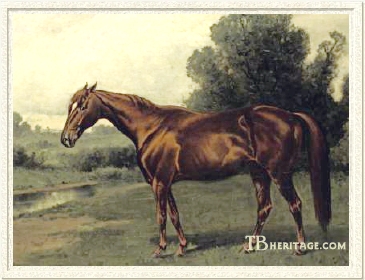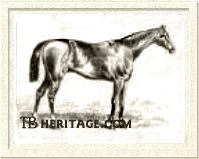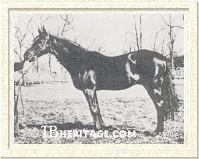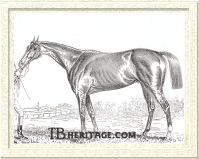|
|
Maggie B.B.

|
|
 |
|
|
The nineteenth century American mare Maggie B.B. was truly an extraordinary broodmare, producing three classic winners, Harold, Panique, and most significantly, Iroquois, the first American-bred to win the Derby Stakes at Epsom. Her laurels rested not only on this fine trio of sons, but on daughters whose descendants have carried her female line forward with great success into the twenty-first century.
Maggie B.B. began life in Kentucky in the spring of 1867. She was bred by James B. Clay, Jr., a grandson of the renowned Kentucky politician Henry Clay. She was sired by Australian, a son of West Australian, first winner of the English Triple Crown. Australian was imported to the United States as a colt along with his dam, the Young Emilius mare Emilia, by Richard Ten Broeck, acting on behalf of A. Keene Richards. Australian proved a good stakes performer in this country. Upon his retirement, he was sent to Woodburn Stud, where he consistently ranked among the leading sires although frequently overshadowed by his more famous studmate Lexington.
Maggie B.B. was out of Madeline, who hailed from the family of Bobadilla, winner of the Ascot Gold Cup in 1828. Mated with Epsom Derby winner Mameluke, Bobadilla foaled the filly Myrtle, who was imported to America. Myrtle in turn was bred to prominent sire Glencoe. The result was a chestnut filly named Magnolia, and beginning with her, the family became intertwined with the breeding fortunes of the Henry Clay family. Magnolia was bred by Dr. W.T. Mercer, and presented by him as a gift to Henry Clay. To a mating with Boston, Magnolia foaled Madeline in 1849. After Henry Clay's death in 1852, Magnolia passed to his son, John M. Clay, who bred several foals from her, most notably Lexington's great son Kentucky.
Various members of Henry Clay's family were involved in breeding runners, and Madeline, the daughter of Magnolia and half-sister to Kentucky, became the property of another of Henry Clay's sons, James. B. Clay. It was he who sent Madeline to Woodburn to be covered by Australian in the spring of 1866. The gentleman died soon after, leaving the pregnant Madeline to his son, James. B. Clay, Jr. The produce was a small chestnut filly with a star on her forehead. Originally called Magpie, the filly's name was changed to honor a lost love.
James B. Clay, Jr. fell deeply in love with Margaret (Maggie) B. Beck, daughter of Senator James Burnie Beck of Kentucky. Senator Beck strongly disapproved of the romance. Despite the fact that his daughter's suitor was a grandson of Kentucky's most famous statesman, some members of the Clay family suffered the shame of a darker side. Henry Clay's eldest son had been institutionalized due to mental illness. John M. Clay had also been institutionalized for a brief time, and James B. Clay, Jr. returned from service in the Civil War with such horrific memories he tried to blot them out by embarking on periodic drinking binges. Senator Beck married his daughter off to James W. Corcoran, nephew of William Wilson Corcoran, the Washington financier, philanthropist, and art collector. Tragically, Maggie Beck Corcoran, aged barely twenty, died just days after her wedding. From the ashes of his ill-fated romance came the permanent name for the diminutive chestnut Leamington filly--Maggie B.B.
Maggie on the Turf
Maggie B.B. ran seven times in two seasons, winning three and placing second in the others. Her debut took place at Lexington and she led from start to finish. In her next start, she was narrowly defeated by Hamburgh, with the highly regarded colts Enquirer and Lyttleton well back of her. Next, at Louisville, Maggie B.B. was beaten only a neck by Lynchburg, with Enquirer and Lyttleton again among the vanquished. Sent to Nashville, Tennessee, Maggie B.B. captured the Young America Stakes, with Lynchburg, Hamburgh, and Enquirer following her to the finish.
Rested for the winter, James B. Clay sold Maggie B.B. to M.A. Littell, who subsequently resold her to Captain T.G. Moore. In Captain Moore's colors, Maggie B.B. did not start until July 14, 1870 at Saratoga, in the Excelsior Stakes. The race was at 1-1/4 miles, and her main competition came from August Belmont's Glenelg, winner the previous year of the Travers Stakes and Jerome Handicap and second in the Belmont Stakes. Glenelg defeated Maggie B.B. , who ran gallantly for second place. Four days later, Maggie B.B. easily took the Sequel Stakes over two miles. Her final start took place at Monmouth Park on July 30th, in the Continental Hotel Stakes. The race was run in mile heats. Maggie B.B. ran fourth, second, and second, the winner being Enquirer, who finished third in the first heat and won the remaining two.
Maggie in the Stud
Maggie B.B. was then sold to breeder Aristides Welch and sent to his Erdenheim Stud, Chestnut Hill, Pennsylvania, near Philadelphia. Welch bred her to Leamington, and Maggie B.B. produced her first foal, a chestnut colt named LORD CLIVE, in 1872. Though he was considered a handsome specimen, Lord Clive achieved little, either on the racecourse or at stud. Maggie B.B.'s next foal, the bay Leamington filly PERA, was noted for her speed, winning many races including the Chesapeake Stakes at Baltimore. As a broodmare, Pera had very few foals and her branch of Maggie B.B.'s family produced nothing of exceptional merit. In 1874, came the chestnut colt MAGNUM BONUM, who was purchased by August Belmont I. Though highly regarded, Magnum Bonum suffered from unsoundness and like his elder brother Lord Clive, achieved nothing notable either as a racer or a stallion.
Jaconet
In 1875 Maggie B.B. produce another daughter by Leamington, the chestnut filly JACONET. This filly was acquired by Pierre Lorillard, a New York businessman who had made his fortune marketing tobacco products. Lorillard soon repented of his purchase. The filly was afflicted with a disease known by horsemen as "big head," and was blemished by a "bony enlargement of the skull." Lorillard decided he did not want her and gave her to Dr. Cattanach, the veterinarian who diagnosed her illness. Dr. Cattanach in turn traded Jaconet back to her breeder, Aristides Welch, for another horse. Welch then sold Jaconet to Kentucky breeders Ezekial Clay and Catesby Woodford, owners of Runnymede Stud near Paris, Kentucky.
Clay and Woodford bred Jaconet to the imported Voltigeur stallion Billet and the result, foaled in 1885, was the bay colt Sir Dixon, winner of the Belmont Stakes. Sir Dixon became a highly successful stallion, leading the American sire list in 1901. His progeny included Agile, winner of the Kentucky Derby; The Butterflies, victress over colts in the 1894 Futurity Stakes; Running Water, winner of the Alabama Stakes; Martha Gorman; Charter Queen; and major producer Audience. Charter Queen was incestuously inbred, for her dam was the mare Magna Carta, another daughter of Jaconet. Bred to Star Shoot, Charter Queen produced the durable performer Star Charter, winner during his career of the Clark Handicap and the Latonia Cup.
Some of the most notable descendants of Jaconet include: Uncle, major winner and leading sire; Par Excellence, victress in the Alabama Stakes; Kentucky Derby winner Lawrin and his full sister, Kentucky Oaks winner Inscolassie; Preakness champion Faultless; Ladkin, victor over French champion Epinard in the 1924 International Special No. 2; Suntica, a winner of the Kentucky Oaks; champion filly Idun; Suburban Handicap winner Captain Alcock; major stakes winner Blazes; and champion filly and Kentucky Oaks winner Rose of Sharon. Prominent broodmare Alablue also descends from Jaconet, and her descendants include Santa Anita Derby winner and major sire Boldnesian; Princessnesian, victress over males in the Hollywood Gold Cup; Spinaway Stakes winner Alanesian; champion filly Revidere; and multiple Grade I winners Cryptoclearance and Harlan's Holiday.
|
|
| 
Harold.
| | Harold
In 1876, Maggie B.B. produced the colt who would become her first classic winner, HAROLD. An elegant golden chestnut colt, Harold became the property of Pierre Lorillard's brother George. Harold was trained by R. Wyndham Walden, who proclaimed Harold the best horse he ever trained. Harold was a champion at two, his victories coming in the Flash Stakes, Saratoga Stakes and the July Stakes, in which he led stablemates Monitor and Idler to the wire. At three, Harold captured the Preakness Stakes.
|
The running of the Withers Stakes, however, proved the ruin of him. Left at the start, the colt's rider attempted to close the tremendous gap between his mount and the field ahead by riding Harold as hard as he could. The gallant colt suffered a ruptured blood vessel and finished unplaced to James R. Keene's duo of Dan Sparling and Spendthrift.
After the Withers came losses in the Belmont and Travers Stakes, to Spendthrift and Falsetto, respectively. Harold made a game try in the Lorillard Stakes, racing prominently from the outset before the effects of that ruptured blood vessel caused him to falter in the last furlong. Harold won only once more in his career before he was retired to stud. An offer of $20,000 was given for Harold when his younger brother Iroquois won the Epsom Derby in 1881, but Walden, acting on behalf of owner Lorillard, turned the offer down. Harold died soon after, having served only one whole season at stud.
Iroquois
In 1877 Maggie B.B. came up barren, but the next year foaled a dark brown son of Leamington destined for fame as IROQUOIS. He was sold to Pierre Lorillard, and was shipped to England as a yearling in 1879. Iroquois was turned over to Jacob Pincus to be trained. Iroquois was out twelve times at two for four victories. Lorillard's colt captured the Chesterfield Stakes at Newmarket and the Lavant Stakes at Goodwood and finished second by only a head to the filly Bal Gal in the July Stakes. |
|
| 
Iroquois
| | At three, Iroquois finished second to Peregrine in the Two Thousand Guineas despite not being totally fit. So impressed was Fred Archer with the performance of Iroquois in the Guineas, that he persuaded Pincus to let him have the mount on the colt for the Derby. Archer rode a confident race, stalking Peregrine before assuming command near the finish and driving to win the classic by a neck. In winning the Derby, Iroquois became the first ever American-bred horse to do so. Iroquois went on that season to win the Prince of Wales's Stakes and St. James's Palace Stakes at Royal Ascot and the St. Leger at Doncaster. In the Champion Stakes, he finished third to the previous year's Derby hero Bend Or.
|
Iroquois, like his brother Harold, suffered a broken blood vessel. He did not compete as a four-year-old. Iroquois returned at five to win the Stockbridge Cup before being returned to the United States. A brief racing career in America was not successful and he was retired from the turf.
Pierre Lorillard at this time was heavily consumed by business priorities and consequently sold many of his horses. The horses were auctioned at Lorillard's Rancocas Stud in New Jersey. General William Harding Jackson, master of Belle Meade Stud near Nashville, Tennessee purchased Iroquois for $20,000. When Jackson's purchases arrived in Nashville, they were put on display at Black's Stable on North Cherry Street. A young boy named Lee Roy Jordan recalled years later, "When Iroquois was brought in people stood around and sung songs. They hollered and they yelped. They made up one song to the tune of Casey Jones, telling how Iroquois had whipped the British." Iroquois led the American sire list in 1892. His best runners included Tammany, winner of the Lawrence Realization; White Frost, winner of the Kentucky Oaks; and Huron, second to Azra in the 1892 Kentucky Derby. Iroquois died on September 17, 1899 at the age of 21 from a kidney ailment and was buried in his paddock at Belle Meade.
Francesca
In 1879, Maggie B.B. foaled her last offspring by Leamington. The foal, from Leamington's final crop, was a bay filly named FRANCESCA. Acquired for racing by the brothers Mike and Phil Dwyer, she was not a performer of any distinction and did not make any immediate impact as a producer. Her branch of Maggie B.B.'s family has brought forth sporadic stakes winners, but nothing of superior quality until the 1930s, when the tough and classy handicap star Rosemont emerged. There have been just a small smattering of stakes winners in the decades since, notably Hopeful Stakes winner Rose Trellis, Venezuelan Group I winners Black Force and Principado, and 2005 stakes-winning colt Snack.
Red and Blue and her daughters
In 1880, Maggie B.B. produced her first foal by Alarm, famed in his racing days as a high class miler. This was the chestnut filly RED AND BLUE. Also raced by the Dwyer brothers, she proved only a mediocre performer. Both she and her sister Francesca were traded by the Dwyer brothers, along with their champion runner Hindoo, to the partners Ezekial Clay and Catesby Woodford of Runnymede Farm for the multiple stakes winning filly Miss Woodford. As a broodmare, Red And Blue produced several foals, the most notable being the Hindoo sisters Bonnie Blue and Sallie McClelland, the latter a victress in the Alabama Stakes.
Bonnie Blue was bred to near-relative Sir Dixon and produced in 1899 the filly Blue Girl, inbred 3x3 to Maggie B.B. Blue Girl became the leading American money winner of the 1901 racing season and winner at three of the Gazelle Handicap. Important members of the Bonnie Blue family have included Futurity Stakes winner Scapa Flow; multiple stakes-winning filly Good Gamble; Spinaway Stakes winner Bonnie Pennant; and Canadian champion Bull Page.
Sallie McClelland, like her sister Bonnie Blue, was bred to Sir Dixon and produced the filly Audience, destined to become the dam of Handicap Triple Crown winner and major sire Whisk Broom II. Significant descendants of Audience included stakes performer The Nut and his half-sisters, the Pennant filly Burgee and the Peter Pan filly Flyatit, the latter dam of American champion filly Top Flight.
Among the prominent descendants of Burgee was the Case Ace filly Carillon, foaled in 1939. Carillon's best offspring was the War Admiral colt Blue Peter, champion American two-year-old of 1948. Blue Peter's younger full sister, Portage, became an important broodmare, with four of her offspring achieving distinction--stakes winner Black Mountain; stakes winner and notable sire Rainy Lake; producer Blue Canoe (ancestress of Peruvian champion Tia Gigi; multiple Japanese Group I winner T.M. Opera O; American stakes-winning and producing mares Funistrada and Serape; and leading American sire Cozzene). Another important daughter of Portage was the Swaps filly Change Water, dam of consistent Maryland-based sire Allen's Prospect, and more importantly, dam of Fall Aspen.
A stakes-winning daughter of Pretense, Fall Aspen became an extraordinary producer, foaling eight stakes winners during a career which saw her named Kentucky Broodmare of the Year in 1994. Fall Aspen died in 1998, but her descendants have helped keep the female line of Maggie B.B. a prominent one. Fall Aspen was either dam, granddam, or third dam of ten Grade/Group I winners and seven champions, including Preakness Stakes winner Timber Country, Irish One Thousand Guineas heroine Mehthaaf, European champion Dubai Millenium, and Grand Prix de Paris champion Fort Wood, destined to become a leading South African sire.
Sallie McClelland produced two other foals which made her name an important one--daughter Martha Gorman, a full sister to Audience, and Frances McClelland, a daughter of Bermuda. Frances McClelland became the third dam of Man o' War's champion son Crusader, classic winner of the Belmont Stakes and dual winner of the Suburban Handicap.
Martha Gorman was sent across the Atlantic to race, and proved good filly, capturing sixteen races. Mated to the French stallion Maintenon, she produced Maintenant. Imported to America for stud duty, Maintenant sired Haste, sire of Belmont Stakes winner Hurryoff and broodmare sire of American Triple Crown champion Count Fleet. Haste, in turn, was mated with an American-bred daughter of English classic winner Lemberg named Zephyretta, whose second dam was Martha Gorman. The result was Seven Pines, inbred to Martha Gorman 3x3. Seven Pines was only a modest stakes-placed performer, but she became the dam of Misty Isle.
Sired by Sickle and foaled in 1938, Misty Isle was a winner of the important Matron Stakes. As a producer, her two most significant offspring were the half-sisters Cosmic Missile and Evening Mist. Sired by Eight Thirty, Evening Mist never raced. At stud, she produced the stakes-winning fillies Taboo and Islay Mist, as well as the winning filly Egyptian. Islay Mist was sired by Roman and foaled in 1949. Through her daughters Bourbon Mist and Ole Liz, full sisters by Double Jay, she became ancestress of some high class performers, including champion filly Life's Magic, and stakes winners Oilfield, Beaconaire, Kittiwake, Sabin, Fatah Flare, Miss Oceana, Kitwood, Larida, and Magic of Life.
Egyptian was by Heliopolis. Her significance comes as the third dam of the Northern Dancer stallion Dixieland Band. Foaled in 1980, Dixieland Band was a good stakes winner. At stud, he has sired over 100 stakes winners. Dixieland Band also has proved a prolific sire of broodmares, being named America's leading broodmare sire at the age of 24 in 2004. |
|
| 
Panique. Image courtesy Keeneland Library.
| | Panique
In 1881, Maggie B.B. foaled another offspring by Alarm, this one the bright chestnut colt PANIQUE. This son of Maggie B.B. was described as a magnificent individual, "deep in the heart and girth...with tremendous quarters." Panique was plagued throughout his racing career by a splint Even with this problem, he was still a high class performer, capturing the Saratoga Stakes at two and the Withers Stakes and Belmont Stakes at three. Shortly thereafter, the Kittsons sold Panique to the Dwyer brothers. Panique, after his Belmont Stakes win failed to win another race.
|
He wound up as a stallion in Council Bluffs, Iowa. There, he sired nothing of note, though one daughter, Quick, became ancestress of several stakes winners, including Blue Grass Stakes and Whitney Handicap winner Plion.
Maggie's Later Foals
In 1882, Aristides Welch sold the Erdenheim Stud to Commodore Norman Kittson and his brother James. However, Maggie B.B. remained at the stud. Barren in 1882, Maggie B.B. foaled WAWEKUS, by Alarm in 1883. Unaccomplished as a runner, Wawekus failed to make much of a mark as a stallion. One daughter, Katie Wawekus, became noteworthy in the pedigrees of early American Quarter Horses, mainly through her son John Wilkens, the sire of Joe Hancock, still to this day considered one of the greatest Quarter Horse racers and stallions of all time.
In 1884, the Kittsons had the stallion Reform in residence at Erdenheim. He was a son of Leamington. None of her foals by Reform proved noteworthy. OKEMA, (bay colt foaled in 1884), achieved no distinction on the racecourse or at stud; OWAS (chestnut colt foaled in 1885) was plagued by a bad hock and at stud made no mark. HOMEOPATHY (chestnut filly foaled in 1887), was a winner but failed to produce any important offspring.
In 1888, the Erdenheim Stud was sold again and many of the horses were sold individually. Maggie B.B. was purchased by American financier and sportsman William Backhouse Astor, whose son, John Jacob Astor would perish in the Titanic disaster. Astor had been a friend of Aristides Welch and so was no stranger to the quality of the bloodstock residing at Erdenheim. The Kittson brothers soon repented selling Maggie B.B. Their sentiment for the old mare was such that they begged Mr. Astor to sell her back to them, which he kindly did. Maggie B.B. remained at Erdenheim, where she produced two more foals. Maggie B.B.'s last two offspring were sired by the imported English stallion Woodlands. Maggie's first Woodlands foal was the chestnut filly HYPATICA (foaled in 1888) and her last was a chestnut colt named FLATLANDS, born in 1889. Hypatica won some minor sweepstakes, and was noteworthy as the second dam of two major stakes winners--Phosphor, winner of the Carter Handicap, and Semprolus, winner of the Flash and National Stallion Stakes. Flatlands achieved no distinction as a racer, running in and winning some cheap purses and selling races. He could only charitably be called a moderate stallion. His daughter Lillie Flat did become the third dam of Travers Stakes winner Burning Star.
Maggie Under the Magnolias
Maggie B.B. died on November 4, 1889, aged 22. James A. Kittson wrote to The Spirit of the Times the following letter. "Our old favorite suffered since yesterday from a stricture of the bowels and died this evening in great pain. It is hardly necessary to add that she is a loss to us that we cannot replace. We will find a place for her under the magnolias." The body of the beloved mare was laid to rest alongside Leamington and the celebrated trotting mare Flora Temple, the "bob-tailed mare" fabled in song. Today, Angus cattle, Cheviot and Dorset sheep, and Belgian draft horses inhabit the fields where over a century ago, Maggie B.B. and her foals grazed. The passage of time has been good to Maggie B.B.'s family, thanks to descendants which have kept her female line one of the most important in American thoroughbred breeding.
--Liz Martiniak
|
|
|
|

